The Influence of Seamounts on the Enrichment of Rare Earth Elements in Sediments—A Case Study of the Marcus-Wake Seamounts in the Western Pacific Ocean
Abstract
1. Introduction
2. Materials and Methods
2.1. Study Area
2.2. Sample Information
2.3. Analytical Method
2.3.1. Grain Size Analysis
2.3.2. Microscopic Identification
2.3.3. Element Analysis
3. Results
3.1. Grain Size
3.2. Mineralogical Characteristics of Coarse Fractions
3.3. Elemental Composition of Sediments
4. Discussion
4.1. Factors Controlling the Chemical Composition of Sediments
4.2. Sources and Carriers of REY
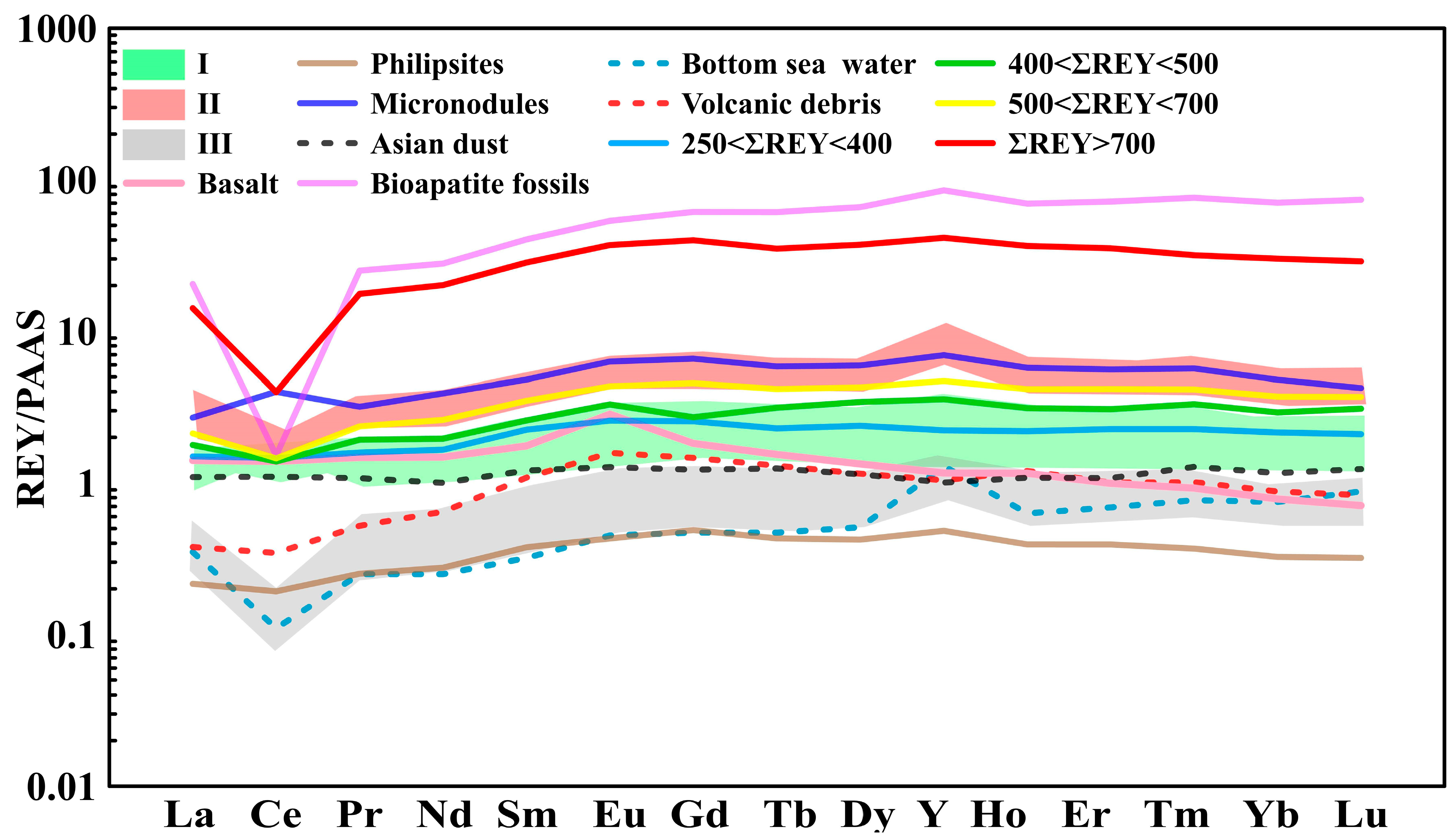
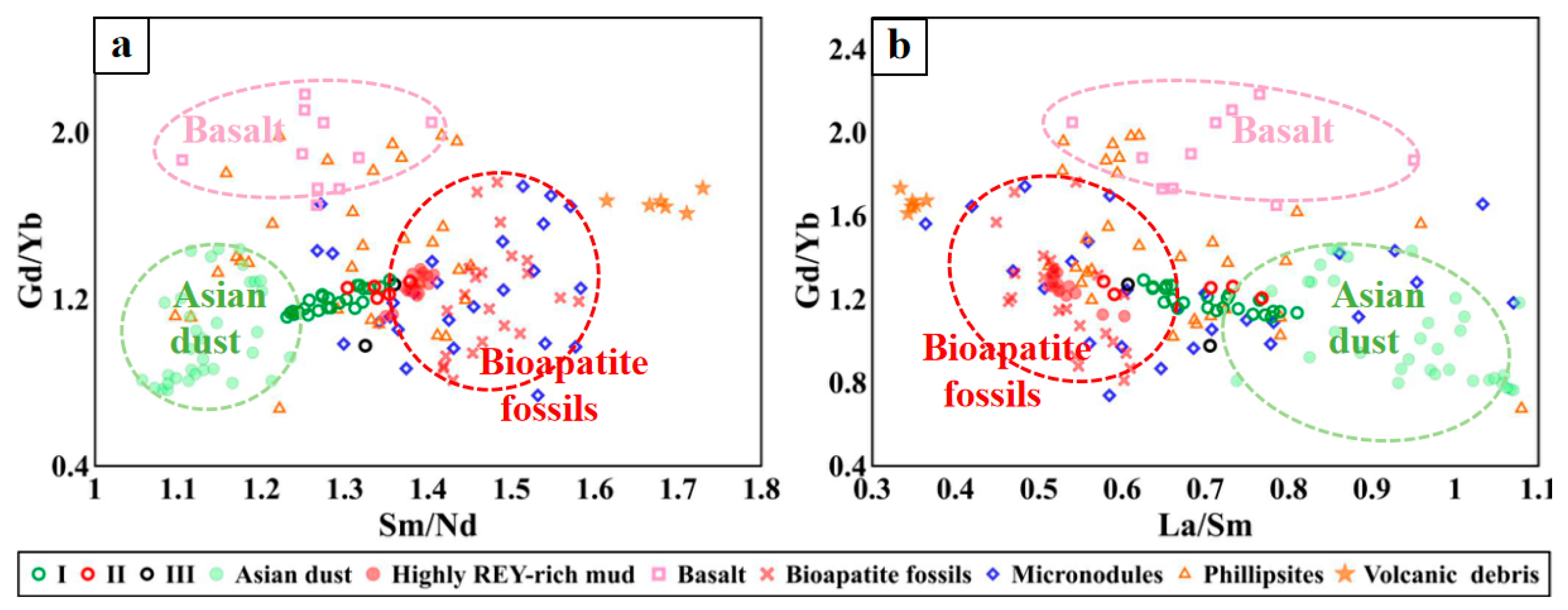
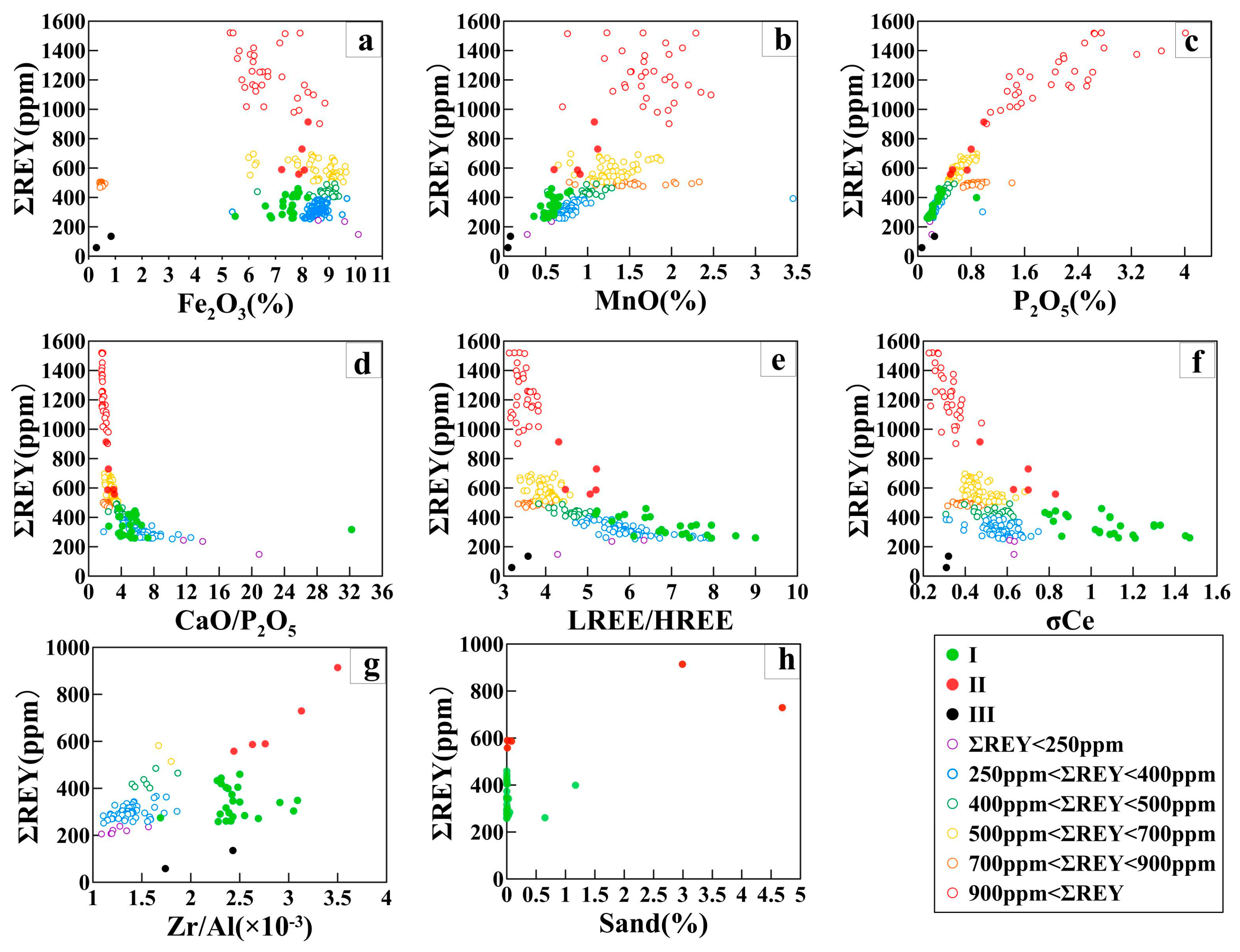
4.3. Effect of Seamounts on REY Enrichment
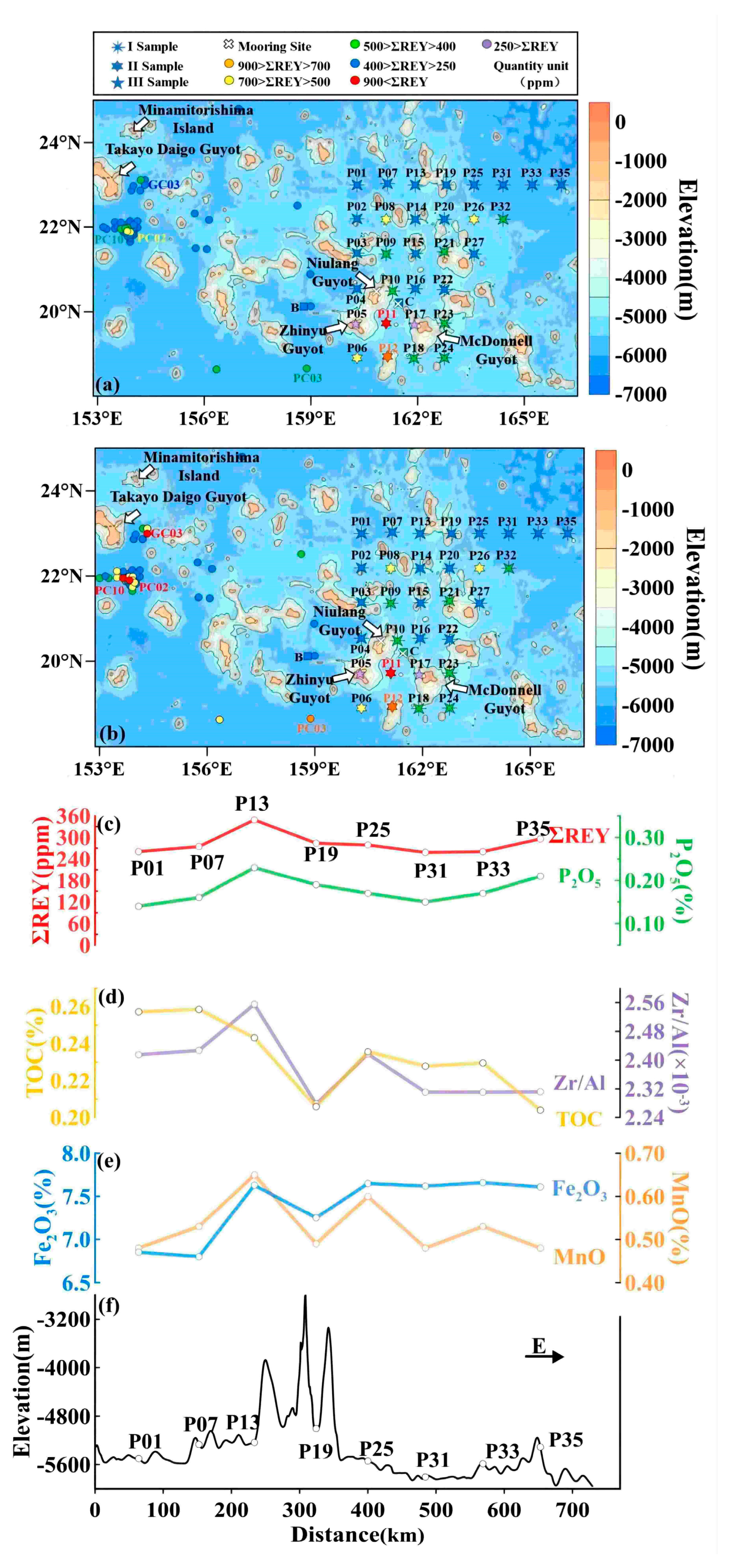
5. Conclusions
Supplementary Materials
Author Contributions
Funding
Institutional Review Board Statement
Informed Consent Statement
Data Availability Statement
Acknowledgments
Conflicts of Interest
References
- Kato, Y.; Fujinaga, K.; Nakamure, K.; Takaya, Y.; Kitamura, K.; Ohta, J.; Toda, R.; Nakashima, T.; Iwamori, H. Deep-sea mud in the Pacific Ocean as a potential resource for rare-earth elements. Nat. Geosci. 2011, 4, 535–539. [Google Scholar] [CrossRef]
- IiJima, K.; Yasukawa, K.; FuJinaga, K.; Nakamura, K.; Machida, S.; Takaya, Y.; Ohta, J.; Haraguchi, S.; Nishio, Y.; Usui, Y.; et al. Discovery of extremely REY-rich mud in the western North Pacific Ocean. Geochem. J. 2016, 50, 557–573. [Google Scholar] [CrossRef]
- Ohta, J.; Yasukawa, K.; Machida, S.; FuJinaga, K.; Nakamura, K.; Takaya, Y.; IiJima, K.; Suzuki, K.; Kato, Y. Geological factors responsible for REY-rich mud in the western North Pacific Ocean: Implications from mineralogy and grain size distributions. Geochem. J. 2016, 50, 591–603. [Google Scholar] [CrossRef]
- Yasukawa, K.; Ohta, J.; Mimura, K.; Tanaka, E.; Takaya, Y.; Usui, Y.; FuJinaga, K.; Machida, S.; Nozaki, T.; IiJima, K.; et al. A new and prospective resource for scandium: Evidence from the geochemistry of deep-sea sediment in the western North Pacific Ocean. Ore Geol. Rev. 2018, 102, 260–267. [Google Scholar] [CrossRef]
- Shi, X.; Bi, D.; Huang, M.; Yu, M.; Luo, Y.; Zhou, T.; Zhang, Z.; Liu, J. Distribution and metallogenesis of deep-sea rare earth elements. Geol. Bull. China 2021, 40, 195–208. (In Chinese) [Google Scholar]
- Bi, D.; Shi, X.; Huang, M.; Yu, M.; Zhou, T.; Zhang, Y.; Zhu, A.; Shi, M.; Fang, X. Geochemical and mineralogical characteristics of deep-sea sediments from the western North Pacific Ocean: Constraints on the enrichment processes of rare earth elements. Ore Geol. Rev. 2021, 138, 104318. [Google Scholar] [CrossRef]
- Nakamure, K.; FuJinaga, K.; Yasukawa, K.; Takaya, Y.; Ohta, J.; Machida, S.; Haraguchi, S.; Kato, Y. Chapter 268—REY-Rich Mud: A Deep-Sea Mineral Resource for Rare Earths and Yttrium. In Handbook on the Physics and Chemistry of Rare Earths; Bünzli, J.G., Pecharsky, V.K., Eds.; Elsevier Science Ltd.: Amsterdam, The Netherlands, 2015; Volume 46, pp. 79–127. [Google Scholar]
- Kashiwabara, T.; Toda, R.; Nakamure, K.; Yasukawa, K.; FuJinaga, K.; Kubo, S.; Nozaki, T.; Suzuki, K.; Kato, Y. Synchrotron X-ray spectroscopic perspective on the formation mechanism of REY-rich muds in the Pacific Ocean. Geochim. Cosmochim. Acta 2018, 240, 274–292. [Google Scholar] [CrossRef]
- Ohta, J.; Yasukawa, K.; Nakamure, K.; Nozaki, T.; Takaya, Y.; Mimura, K.; FuJinaga, K.; Nakamure, K.; Usui, Y.; Kimira, J.; et al. Fish proliferation and rare-earth deposition by topographically induced upwelling at the late Eocene cooling event. Sci. Rep. 2020, 18, 9896. [Google Scholar] [CrossRef]
- Ohta, J.; Yasukawa, K.; Nakamure, K.; FuJinaga, K.; IiJima, K.; Kato, Y. Geological features and resource potential of deep-sea mud highly enriched in rare-earth elements in the Central Pacific Basin and the Penrhyn Basin. Ore Geol. Rev. 2021, 139, 104440. [Google Scholar] [CrossRef]
- Zhou, T.; Shi, X.; Huang, M.; Yu, M.; Bi, D.; Ren, X.; Yang, G.; Zhu, A. The Influence of Hydrothermal Fluids on the REY-Rich Deep-Sea Sediments in the Yupanqui Basin, Eastern South Pacific Ocean: Constraints from Bulk Sediment Geochemistry and Mineralogical Characteristics. Minerals 2020, 10, 1141. [Google Scholar] [CrossRef]
- Haley, B.A.; Klinkhammer, G.P.; McManus, J. Rare earth elements in pore waters of marine sediments. Geochim. Cosmochim. Acta 2004, 68, 1265–1279. [Google Scholar] [CrossRef]
- Schacht, U.; Wallmann, K.; Kutterolf, S. The influence of volcanic ash alteration on the REE composition of marine pore waters. J. Geochem. Explor. 2010, 106, 176–187. [Google Scholar] [CrossRef]
- Yasukawa, K.; Liu, H.J.; FuJinaga, K.; Machida, S.; Haraguchi, S.; Ishii, T.; Nakamure, K.; Kato, Y. Geochemistry and mineralogy of REY-rich mud in the eastern Indian Ocean. J. Asian Earth Sci. 2014, 93, 25–36. [Google Scholar] [CrossRef]
- Yasukawa, K.; Ohta, J.; Miyazaki, T.; Vaglarov, B.S.; Chang, Q.; Ueki, K.; Toyama, C.; Kimira, J.; Tanaka, E.; Nakamure, K.; et al. Statistic and Isotopic Characterization of Deep-Sea Sediments in the Western North Pacific Ocean: Implications for Genesis of the Sediment Extremely Enriched in Rare Earth Elements. Geochem. Geophys. Geosystems 2019, 7, 3402–3430. [Google Scholar] [CrossRef]
- Tanaka, E.; Nakamure, K.; Yasukawa, K.; Minura, K.; FuJinaga, K.; IiJima, K.; Nozaki, T.; Kato, Y. Chemostratigraphy of deep-sea sediments in the western North Pacific Ocean: Implications for genesis of mud highly enriched in rare-earth elements and yttrium. Ore Geol. Rev. 2020, 119, 103392. [Google Scholar] [CrossRef]
- Tanaka, E.; Nakamure, K.; Yasukawa, K.; Minura, K.; FuJinaga, K.; Ohta, J.; IiJima, K.; Nozaki, T.; Machida, S.; Kato, Y. Chemostratigraphic Correlations of Deep-Sea Sediments in the Western North Pacific Ocean: A New Constraint on the Distribution of Mud Highly Enriched in Rare-Earth Elements. Minerals 2020, 10, 575. [Google Scholar] [CrossRef]
- Liao, J.; Sun, X.; Li, D.; Sa, R.; Lu, Y.; Lin, Z.; Xu, L.; Zhan, R.; Pan, Y.; Xu, H. New insights into nanostructure and geochemistry of bioapatite in REE-rich sediments: LA-ICP-MS, TEM, and Z-contrast imaging studies. Chem. Geol. 2019, 512, 58–68. [Google Scholar] [CrossRef]
- Deng, Y.; Guo, Q.; Liu, C.; He, G.; Cao, J.; Liao, J.; Liu, C.; Wang, H.; Zhou, J.; Liu, Y.; et al. Early diagenetic control on the enrichment and fractionation of rare earth elements in deep-sea sediments. Sci. Adv. 2022, 8, eabn5466. [Google Scholar] [CrossRef]
- Wang, F.; He, G.; Deng, X.; Yang, Y.; Ren, J. Fish Teeth Sr Isotope Stratigraphy and Nd Isotope Variations: New Insights on REY Enrichments in Deep-Sea Sediments in the Pacific. J. Mar. Sci. Eng. 2021, 9, 1379. [Google Scholar] [CrossRef]
- Deng, Y.; Guo, Q.; Zhu, J.; He, G.; Yang, Y.; Cao, J.; Ren, J.; Liu, Y.; Famiyeh, L.; Guo, B.; et al. Significant contribution of seamounts to the oceanic rare earth elements budget. Gondwana Res. 2022, 112, 71–81. [Google Scholar] [CrossRef]
- Turnewitsch, R.; Falahat, S.; Nycander, J.; Dale, A.; Scott, R.B.; Furnival, D. Deep-sea fluid and sediment dynamics—Influence of hill- to seamount-scale seafloor topography. Earth Sci. Rev. 2013, 127, 203–241. [Google Scholar] [CrossRef]
- Jiang, X.; Dong, C.; Ji, Y.; Wang, C.; Shu, Y.; Liu, L.; Ji, J. Influences of Deep-Water Seamounts on the Hydrodynamic Environment in the Northwestern Pacific Ocean. J. Geophys. Res. Ocean. 2021, 126, e2021JC017396. [Google Scholar] [CrossRef]
- Ezer, T. On the Interaction between the Gulf Stream and the New England Seamount Chain. J. Phys. Oceanogr. 1994, 24, 191–204. [Google Scholar] [CrossRef][Green Version]
- Roden, G.I. Effect of seamounts and seamount chains on ocean circulation and thermohaline structure. Seamounts Isl. Atolls 1987, 43, 335–354. [Google Scholar]
- Holmes, R.M.; Lavergne, C.D.; McDougall, T. Ridges, seamounts, troughs, and bowls: Topographic control of the dianeutral circulation in the Abyssal Ocean. J. Phys. Oceanogr. 2018, 48, 861–882. [Google Scholar] [CrossRef]
- Bi, D.; Shi, X.; Huang, M.; Yu, M.; Shen, F.; Liu, J.; Zhou, T.; Chen, T.; Shi, F.; Wang, X.; et al. Dating Pelagic Sediments from the Northwestern Pacific Ocean by Integration of Multi-geochronologic Approaches. Ore Geol. Rev. 2023, 161, 105614. [Google Scholar] [CrossRef]
- Koppers, A.A.; Staudigel, H.; Pringle, M.S.; Wijbrans, J.R. Short-lived and discontinuous intraplate volcanism in the South Pacific: Hot spots or extensional volcanism? Geochem. Geophys. Geosystems 2003, 4, 1089. [Google Scholar] [CrossRef]
- Xu, J.; Zheng, Y.; Bao, G.; Wu, X.; Zhang, K.; Jin, X. Research of seamount micro-topography based on acoustic deep-tow system investigation: A case from the Marcus-Wake Ridge area. J. Mar. Sci. 2011, 29, 17–24. (In Chinese) [Google Scholar]
- Weiss, T.L.; Linsley, B.K.; Gordon, A.L. Pacific North Equatorial Current bifurcation latitude and Kuroshio Current shifts since the Last Glacial Maximum inferred from a Sulu Sea thermocline reconstruction. Quat. Sci. Rev. 2021, 264, 106999. [Google Scholar] [CrossRef]
- Kawabe, M.; Fujio, S. Pacific ocean circulation based on observation. J. Oceanogr. 2010, 66, 389–403. [Google Scholar] [CrossRef]
- Kawabe, M.; Fujio, S.; Yanagimoto, D. Deep-water circulation at low latitudes in the western North Pacific. Deep Sea Res. Part I Oceanogr. Res. Pap. 2003, 50, 636–656. [Google Scholar] [CrossRef]
- Kawabe, M.; Fujio, S.; Yanagimoto, D.; Tanaka, K. Water masses and currents of deep circulation southwest of the Shatsky Rise in the western North Pacific. Deep Sea Res. Part I Oceanogr. Res. Pap. 2009, 56, 1675–1681. [Google Scholar] [CrossRef]
- Hu, R.; Piotrowski, A.M. Neodymium isotope evidence for glacial-interglacial variability of deepwater transit time in the Pacific Ocean. Nat. Commun. 2018, 9, 4709. [Google Scholar] [CrossRef] [PubMed]
- Frey, F.A.; Coffin, M.; Wallace, P.J.; Quilty, P.G. Proceedings of the Ocean Drilling Program, Scientific Results. Vol. 183. Kerguelen Plateau-Broken Ridge: A Large Igneous Province: Covering Leg 183 DV “Joides Resolution”; Texas A&M University Ocean Drilling Program: College Station, TX, USA, 2003; pp. 1135–1142. [Google Scholar]
- Deng, Y.; Ren, J.; Guo, Q.; Cao, J.; Wang, H.; Liu, C. Geochemistry characteristics of REY-rich sediment from deep sea in Western Pacific, and their indicative significance. Acta Petrol. Sin. 2018, 34, 733–747. (In Chinese) [Google Scholar]
- Deng, Y.; Ren, J.; Guo, Q.; Wang, H.; Yu, Z.; Liu, C. Trace Elements Geochemistry Characteristics of Seawater and Porewater in Deep⁃Water Basin, Western Pacific. Earth Sci. 2019, 44, 3102–3114. (In Chinese) [Google Scholar]
- Qiu, Z.; Ma, W.; Zhang, X.; Ren, J. Geochemical characteristics of sediments in the southeast sea area of Minamitorishima Island and their indication of rare earth elements resources. Geol. Sci. Technol. Inf. 2019, 38, 205–214. (In Chinese) [Google Scholar]
- Qiu, Z.; Ma, W.; Zhang, X.; Dong, Y.; Zhang, W.; Yang, K. Geochemical characteristics of surface sediments in the northwestern Pacific and their indication of materials sources. J. Zhejiang Univ. (Sci. Ed.) 2020, 47, 345–369. (In Chinese) [Google Scholar]
- Luo, S.; Ren, J.; He, G.; Deng, X. Geochemical Characteristics of Polymetallic Nodules and Their Surface Sediments in the Western Pacific: Effect of Sedimentary Environment on Nodule Growth. Mar. Geol. Quat. Geol. 2023, 43, 119–135. (In Chinese) [Google Scholar]
- Ren, J.; He, G.; Yao, H.; Zhang, H.; Yang, S.; Deng, X.; Zhu, K. Geochemistry and Significance of REE and PGE of the CobaIt-Rich Crusts from West Pacific Ocean Seamounts. Earth Sci. 2016, 41, 1745–1757. (In Chinese) [Google Scholar]
- Yi, L.; Hu, B.; Zhao, J.; Jiang, X.; Shu, Y.; Wang, X.; Guo, J.; Wang, F.; Ding, X.; Liu, G.; et al. Magneto stratigraphy of Abyssal Deposits in the Central Philippine Sea and Regional Sedimentary Dynamics During the Quaternary. Paleoceanogr. Paleoclimatol. 2022, 37, e2021PA004365. [Google Scholar] [CrossRef]
- Taylor, S.R.; McLennan, S.M. The Continental Crust: Its Composition and Evolution: An Examination of the Geochemical Record Preserved in Sedimentary Rocks; Blackwell: London, UK, 1985; pp. 57–72. [Google Scholar]
- Pourmand, A.; Dauphas, N.; Ireland, T.J. A novel extraction chromatography and MC-ICP-MS technique for rapid analysis of REE, Sc and Y: Revising CI-chondrite and Post-Archean Australian Shale (PAAS) abundances. Chem. Geol. 2012, 291, 38–54. [Google Scholar] [CrossRef]
- Dunlea, A.G.; Murray, R.W.; Sauvage, J.; Spivack, A.J.; Harris, R.N.; D’Hondt, S. Dust, volcanic ash, and the evolution of the South Pacific Gyre through the Cenozoic. Paleoceanography 2015, 30, 1078–1099. [Google Scholar] [CrossRef]
- Yuan, C.; Meng, F.; Yao, Y.; Ni, J. Geochemical speciation and spatial distributions of phosphorus in surface sediments from the basin of the Marcus-Wake seamounts in the western Pacific Ocean. Acta Oceanol. Sin. 2022, 41, 80–90. [Google Scholar] [CrossRef]
- Dymond, J.; Suess, E.; Lyle, M. Barium in Deep-Sea Sediment: A Geochemical Proxy for Paleoproductivity. Paleoceanography 1992, 7, 163–181. [Google Scholar] [CrossRef]
- Zhang, J.; Meng, X.; Xia, P. The Ba cycle during the early diagenesis of deep-sea sediments and its implication for paleooceangraphiacal environmental. Adv. Mar. Sci. 2009, 27, 275–280. (In Chinese) [Google Scholar]
- McLennan, S.M. Rare earth elements in sedimentary rocks: Influences of provenance and sedimentary processes. Rev. Miner. Geochem. 1989, 21, 169–200. [Google Scholar]
- Cullers, R.L. The controls on the major and trace element variation of shales, siltstones sandstones of Pennsylva-nian-Permian age from uplifted continental block in Colorado to platform sediment in Kansas, USA. Geochim. Cosmochim. Acta 1994, 58, 4955–4972. [Google Scholar] [CrossRef]
- Honda, M.; Shimizu, H. Geochemical, mineralogical and sedimentological studies on the Taklimakan desert sands. Sedimentology 1998, 45, 1125–1143. [Google Scholar] [CrossRef]
- Cullers, R.L.; Barrett, T.; Carlson, R.; Robinson, B. Rare-earth element and mineralogical changes in Holocene soil and stream sediment: A case study in the Wet Mountains, Colorado, USA. Chem. Geol. 1987, 63, 275–297. [Google Scholar] [CrossRef]
- Ming, B.; Sylvain, G.; Han, J. Geochemistry of the Xining, Xifeng and Jixian sections, Loess Plateau of China: Eolian dust provenance and paleosol evolution during the last 140 ka. Chem. Sci. 2000, 178, e2021PA004365. [Google Scholar]
- Li, Y.; Liang, P.; Song, Y.; Li, X.; Yang, S.; Chen, X.; Zong, X.; Shukurov, N.; Li, Y. Unraveling source-to-sink dust transport in Central and East Asia by identifying provenances of aeolian sediments. Atmos. Res. 2023, 293, 106929. [Google Scholar] [CrossRef]
- Chen, Q.; Li, Z.; Dong, S.; Wang, N.; Lai, D.; Ning, K. Spatial Variations in the Chemical Composition of Eolian Sediments in Hyperarid Regions: A Case Study from the Badain Jaran Desert, Northwestern China. J. Sediment. Res. 2018, 88, 290–300. [Google Scholar] [CrossRef]
- Chen, X.; Song, Y.; Li, Y.; Huang, Y.; Zhou, X.; Fan, Y. Provenance of sub-aerial surface sediments in the Tarim Basin, Western China. Catena 2020, 198, 105014. [Google Scholar] [CrossRef]
- Jiang, Q.; Yang, X. Sedimentological and Geochemical Composition of Aeolian Sediments in the Taklamakan Desert: Implications for Provenance and Sediment Supply Mechanisms. J. Geophys. Res. Earth Surf. 2019, 124, 1217–1237. [Google Scholar] [CrossRef]
- Zhao, W.; Sun, Y.; Balsam, W.; Lu, H.; Liu, L.; Chen, J.; Ji, J. Hf-Nd isotopic variability in mineral dust from Chinese and Mongolian deserts: Implications for sources and dispersal. Sci. Rep. 2014, 4, 5837. [Google Scholar] [CrossRef] [PubMed]
- Zhang, H.; Zhou, J.; Yuan, P.; Dong, Y.; Fan, W.; Chu, F.; Xiao, W.; Liu, D. Highly positive Ce anomalies of hydrogenetic ferromanganese micronodules from abyssal basins in the NW and NE Pacific: Implications for REY migration and enrichment in deep-sea sediments. Ore Geol. Rev. 2023, 154, 105324. [Google Scholar] [CrossRef]
- Liao, J.; Sun, X.; Wu, Z.; Sa, R.; Yao, G.; Lu, Y.; Li, D.; Liu, Y.; Deng, Y.; Pan, Y. Fe-Mn (oxyhydr)oxides as an indicator of REY enrichment in deep-sea sediments from the central North Pacific. Ore Geol. Rev. 2019, 112, 103044. [Google Scholar] [CrossRef]
- Yasukawa, K.; Kino, S.; Azami, K.; Tanaka, E.; Minura, K.; Ohta, J.; FuJinaga, K.; Nakamure, K.; Kato, Y. Geochemical features of Fe-Mn micronodules in deep sea sediments of the western North Pacific Ocean: Potential for co-product metal extraction from REY-rich mud. Ore Geol. Rev. 2020, 127, 103805. [Google Scholar] [CrossRef]
- Liao, J.; Chen, J.; Sun, X.; Wu, Z.; Deng, Y.; Shi, X.; Wang, Y.; Chen, Y.; Koschinsky, A. Quantifying the controlling mineral phases of rare-earth elements in deep-sea pelagic sediments. Chem. Geol. 2022, 595, 120792. [Google Scholar] [CrossRef]
- Manceau, A.; Paul, S.; Simionovici, A.L.; Magnin, V.; Balvay, M.; Findling, N.; Rovezzi, M.; Muller, S.; Garbe-Schönberg, D.; Koschinsky, A. Fossils Bioapatites with Extremely High Concentrations of Rare Earth Elements and Yttrium from Deep-Sea Pelagic Sediments. ACS Earth Space Chem. 2022, 6, 2093–2103. [Google Scholar] [CrossRef]
- Takahashi, Y.; Hayasaka, Y.; Morita, K.; Kashiwabara, E.; Nakada, R.; Marcus, M.A.; Kato, K.; Tanaka, K.; Shimizu, H. Transfer of rare earth elements (REE) from manganese oxides to phosphates during early diagenesis in pelagic sediments inferred from REE patterns, X-ray absorption spectroscopy, and chemical leaching method. Geochem. J. 2015, 49, 653–674. [Google Scholar] [CrossRef]
- Wei, X.; Shi, X.; Xu, Y.G.; Castillo, P.R.; Zhang, Y.; Zhang, L.; Zhang, H. Mid-Cretaceous Wake seamounts in NW Pacific originate from secondary mantle plumes with Arago hotspot composition. Chem. Geol. 2022, 587, 120632. [Google Scholar] [CrossRef]
- Wang, H.; Yi, L.; Deng, X.; He, G. Geochemical and Mineral Properties of Quaternary Deep-Sea Sediments in the Central-Tropical Pacific and Its Response to the Mid-Pleistocene Transition. J. Mar. Sci. Eng. 2021, 9, 1254. [Google Scholar] [CrossRef]
- Ma, J.; Song, J.; Li, X.; Yuan, H.; Li, N.; Duan, L.; Wang, Q. Environmental characteristics in three seamount areas of the Tropical Western Pacific Ocean: Focusing on nutrients. Mar. Pollut. Bull. 2019, 143, 163–174. [Google Scholar] [CrossRef] [PubMed]
- Ma, J.; Song, J.; Li, X.; Yuan, H.; Li, N.; Duan, L.; Wang, Q. Control factors of DIC in the Y3 seamount waters of the Western Pacific Ocean. J. Oceanol. 2020, 38, 1215–1224. [Google Scholar] [CrossRef]
- Sun, X.; Chen, J.; Chen, B.; Lin, C.; Liu, Y.; Huang, J.; Pan, Z.; Zhou, K.; He, Q.; Kuang, F.; et al. The particle fluxes in sediment traps from Niulang Guyot area in the Northwest Pacific. Acta Oceanol. Sin. 2022, 41, 34–44. [Google Scholar] [CrossRef]
- Beaulieu, S.E. Accumulation and fate of phytodetritus on the sea floor. Oceanogr. Mar. Biol. 2002, 40, 171–232. [Google Scholar]
- Howe, J.A.; Stoker, M.S.; Masson, D.G.; Pudsey, C.J.; Morris, P.; Larter, R.D.; Bulat, J. Seabed morphology and the bottom-current pathways around Rosemary Bank seamount, northern Rockall Trough, North Atlantic. Mar. Petrol. Geol. 2006, 23, 165–181. [Google Scholar] [CrossRef]
- Turnewitsch, R.; Reyss, J.; Chapman, D.C.; Thomson, J.; Lampitt, R.S. Evidence for a sedimentary fingerprint of an asymmetric flow field surrounding a short seamount. Earth Planet. Sci. Lett. 2004, 222, 1023–1036. [Google Scholar] [CrossRef]
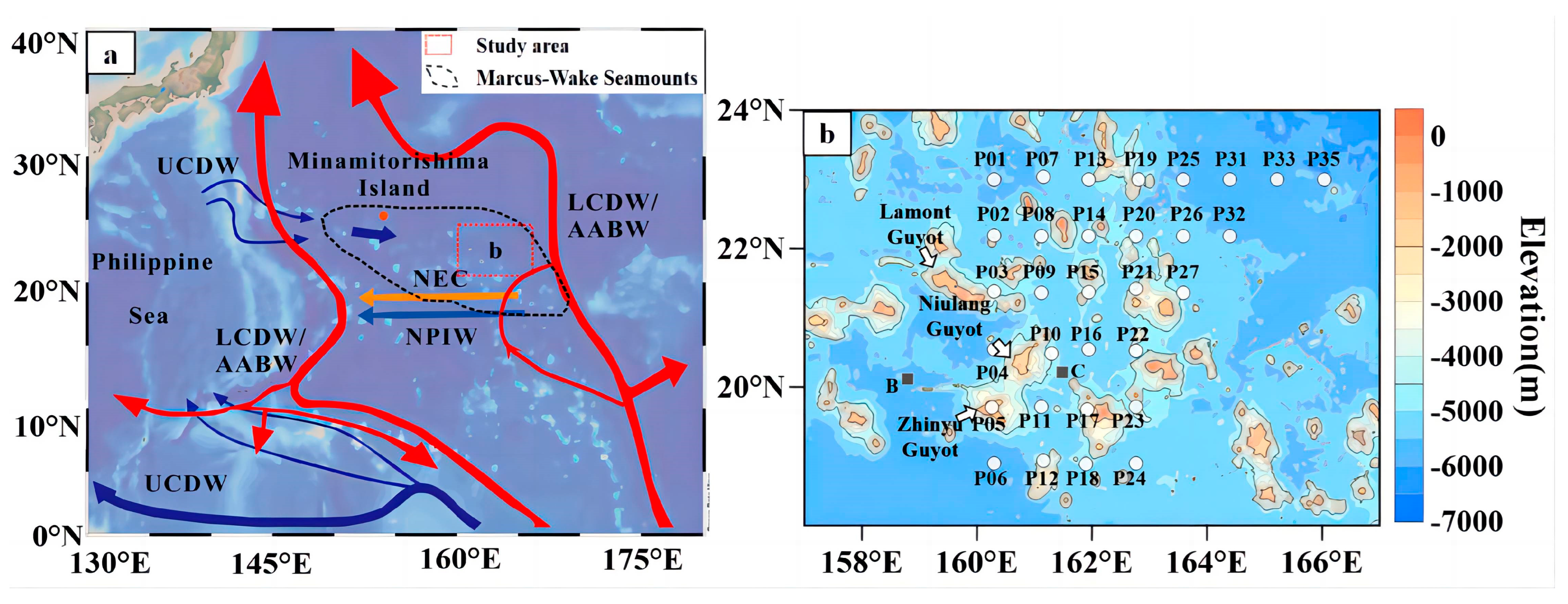
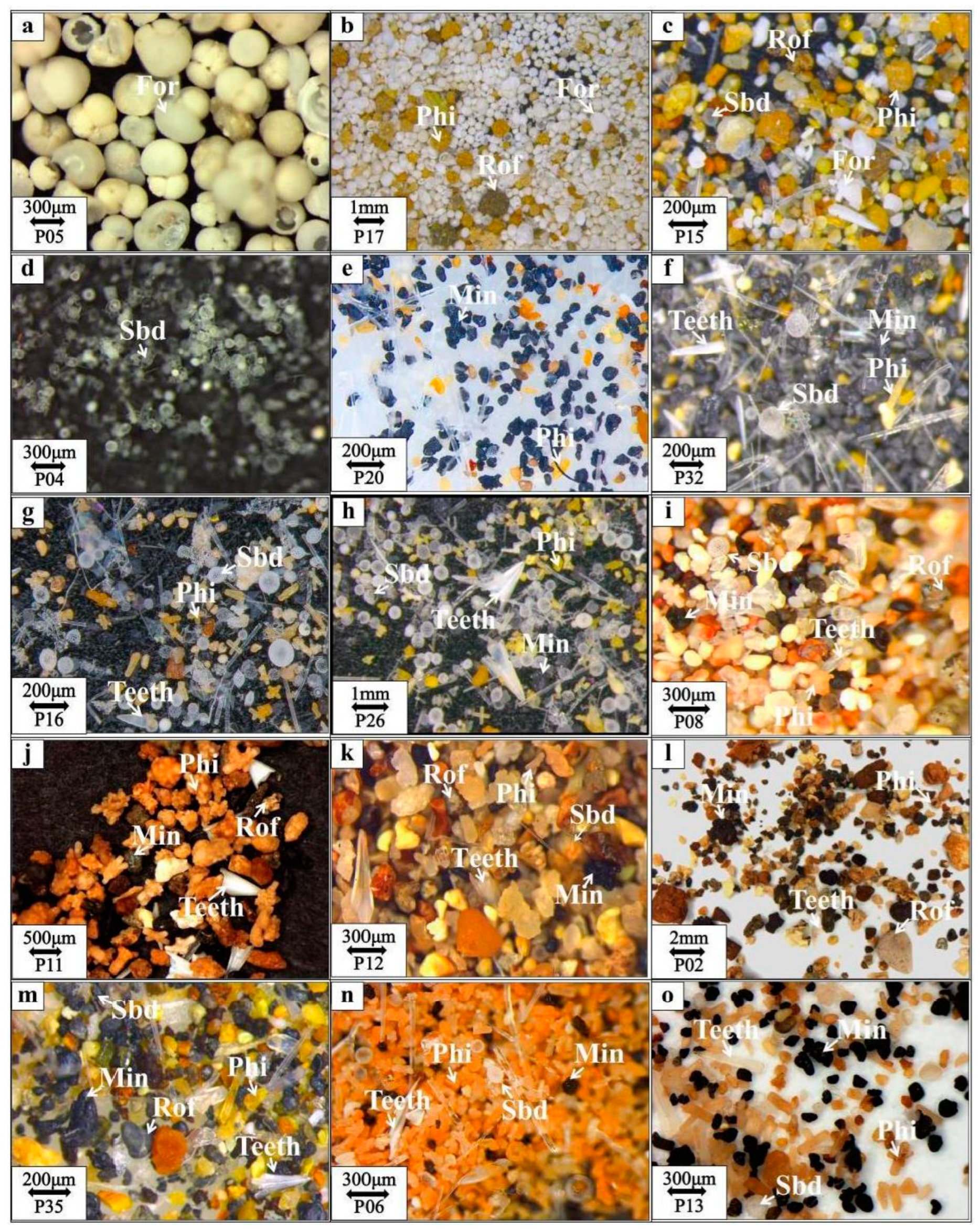
| Sta- tion | Depth /m | Bb Sand /% | Bb Mz /μm | Bf Sand /% | Bf Mz /μm | Tra | Rof | Phi | Fish Teeth | Min | Sbd | For | SiO2 /% | Al2O3 /% | Fe2O3 /% | MnO /% | P2O5 /% | CaCO3 /% | TOC /% | Co /ppm | Ni /ppm | ΣREY /ppm |
|---|---|---|---|---|---|---|---|---|---|---|---|---|---|---|---|---|---|---|---|---|---|---|
| P01 | 5489 | 26.18 | 12.79 | 0.65 | 4.41 | + | - | - | - | - | +++ | - | 54.18 | 14.84 | 6.85 | 0.48 | 0.14 | 0.43 | 0.26 | 56.69 | 96.04 | 260.8 |
| P02 | 4950 | 3.28 | 4.34 | 1.17 | 4.22 | ++ | +++ | ++ | ++ | ++ | ++ | - | 53.13 | 16.70 | 8.20 | 0.64 | 0.88 | 0.64 | 0.27 | 68.14 | 153.52 | 399.2 |
| P03 | 4763 | 50.18 | 38.10 | 0.03 | 4.26 | - | - | - | - | - | +++ | - | 55.13 | 11.98 | 5.49 | 0.36 | 0.23 | 0.34 | 0.26 | 42.94 | 87.84 | 271.5 |
| P04 | 5375 | 40.75 | 22.68 | 0.00 | 3.95 | - | - | - | - | - | +++ | - | 53.65 | 15.48 | 7.28 | 0.64 | 0.23 | 0.51 | 0.28 | 77.47 | 144.32 | 339.7 |
| P05 | 1344 | 12.78 | 7.56 | / | / | - | - | - | - | - | - | +++ | 1.30 | 0.73 | 0.29 | 0.05 | 0.06 | 90.56 | 0.01 | 7.54 | 12.92 | 58.2 |
| P06 | 5662 | 1.39 | 4.31 | 0.01 | 4.07 | + | + | +++ | +++ | + | ++ | - | 51.14 | 16.26 | 7.87 | 0.91 | 0.49 | 0.48 | 0.29 | 103.04 | 190.10 | 558.0 |
| P07 | 5405 | 7.47 | 5.53 | 0.00 | 4.36 | - | - | - | - | - | +++ | - | 55.20 | 14.72 | 6.80 | 0.53 | 0.16 | 0.36 | 0.26 | 57.04 | 103.76 | 274.6 |
| P08 | 5190 | 5.31 | 4.88 | 0.08 | 4.15 | +++ | +++ | +++ | ++ | ++ | + | - | 53.14 | 16.34 | 8.08 | 0.88 | 0.74 | 0.48 | 0.21 | 92.90 | 315.33 | 586.6 |
| P09 | 5169 | 1.16 | 4.32 | 0.01 | 4.33 | + | ++ | +++ | ++ | ++ | ++ | - | 54.63 | 16.66 | 7.63 | 0.67 | 0.30 | 0.35 | 0.21 | 73.00 | 146.98 | 403.7 |
| P10 | 4573 | 0.02 | 3.90 | 0.00 | 4.22 | + | ++ | +++ | ++ | ++ | ++ | - | 55.32 | 17.16 | 7.84 | 0.57 | 0.32 | 0.27 | 0.22 | 66.00 | 144.81 | 459.8 |
| P11 | 5364 | 23.38 | 10.89 | 2.99 | 4.62 | + | +++ | +++ | +++ | +++ | + | - | 50.96 | 15.84 | 8.22 | 1.08 | 0.99 | 0.14 | 0.19 | 127.47 | 254.56 | 913.9 |
| P12 | 4872 | 17.95 | 8.61 | 4.69 | 4.29 | + | +++ | +++ | ++ | +++ | + | - | 50.73 | 15.84 | 7.99 | 1.12 | 0.80 | 0.57 | 0.24 | 128.50 | 281.88 | 729.3 |
| P13 | 5451 | 0.60 | 3.95 | 0.00 | 3.96 | - | - | ++ | ++ | ++ | ++ | - | 53.02 | 16.61 | 7.63 | 0.65 | 0.23 | 0.82 | 0.24 | 72.50 | 144.94 | 348.7 |
| P14 | 5036 | 0.00 | 3.74 | 0.00 | 3.94 | - | - | + | - | ++ | ++ | - | 53.62 | 16.73 | 7.64 | 0.55 | 0.22 | 0.70 | 0.23 | 66.44 | 129.86 | 346.3 |
| P15 | 4423 | 0.40 | 3.70 | 0.03 | 4.24 | + | + | +++ | - | + | + | + | 46.77 | 14.74 | 6.62 | 0.44 | 0.23 | 11.58 | 0.29 | 53.31 | 119.58 | 341.7 |
| P16 | 5101 | 1.44 | 4.61 | 0.00 | 4.72 | - | + | + | + | + | +++ | - | 53.21 | 16.00 | 7.28 | 0.60 | 0.30 | 0.31 | 0.26 | 69.79 | 143.04 | 373.5 |
| P17 | 3303 | 17.76 | 8.88 | / | / | - | + | ++ | + | - | + | +++ | 5.65 | 1.90 | 0.84 | 0.08 | 0.25 | 84.50 | 0.05 | 9.66 | 21.16 | 135.3 |
| P18 | 5440 | 0.27 | 4.12 | 0.00 | 4.01 | - | + | +++ | ++ | +++ | +++ | - | 51.94 | 16.57 | 7.88 | 0.76 | 0.37 | 0.72 | 0.22 | 89.30 | 157.30 | 432.9 |
| P19 | 4984 | 11.73 | 7.54 | 0.05 | 4.23 | - | - | + | - | - | +++ | - | 54.37 | 16.01 | 7.25 | 0.49 | 0.19 | 0.49 | 0.21 | 56.70 | 110.67 | 284.0 |
| P20 | 5365 | 0.10 | 3.73 | 0.01 | 4.30 | - | - | + | ++ | + | +++ | - | 53.11 | 16.47 | 7.55 | 0.60 | 0.22 | 0.76 | 0.24 | 68.22 | 141.18 | 303.6 |
| P21 | 4623 | 0.48 | 3.76 | 0.00 | 4.09 | + | - | ++ | ++ | ++ | ++ | - | 53.60 | 16.73 | 7.68 | 0.53 | 0.33 | 0.77 | 0.24 | 66.27 | 143.36 | 419.8 |
| P22 | 4891 | 0.99 | 3.96 | 0.00 | 3.90 | + | - | ++ | +++ | ++ | + | - | 53.63 | 16.59 | 7.58 | 0.59 | 0.22 | 0.55 | 0.27 | 71.51 | 148.44 | 316.9 |
| P23 | 5029 | 0.94 | 4.24 | 0.00 | 4.13 | - | ++ | +++ | +++ | ++ | + | - | 54.10 | 16.77 | 7.81 | 0.58 | 0.34 | 0.44 | 0.25 | 71.65 | 142.34 | 404.7 |
| P24 | 5258 | 2.17 | 4.31 | 0.00 | 3.72 | - | - | ++ | + | ++ | +++ | - | 51.92 | 16.30 | 7.84 | 0.79 | 0.37 | 0.56 | 0.23 | 102.31 | 171.98 | 443.6 |
| P25 | 5536 | 0.02 | 3.60 | 0.00 | 4.17 | - | - | + | ++ | + | +++ | - | 53.56 | 16.69 | 7.65 | 0.60 | 0.17 | 0.76 | 0.24 | 77.50 | 147.81 | 279.0 |
| P26 | 5409 | 0.72 | 4.88 | 0.01 | 4.60 | - | - | ++ | +++ | + | +++ | - | 53.99 | 16.17 | 7.23 | 0.60 | 0.52 | 0.91 | 0.22 | 75.01 | 153.75 | 589.4 |
| P27 | 4945 | 0.00 | 4.11 | 0.00 | 3.94 | - | - | + | + | +++ | +++ | - | 53.63 | 16.94 | 7.68 | 0.53 | 0.19 | 0.45 | 0.21 | 61.39 | 126.18 | 290.4 |
| P31 | 5762 | 0.00 | 3.69 | 0.00 | 3.77 | + | - | - | - | + | + | - | 53.03 | 16.85 | 7.62 | 0.48 | 0.15 | 0.41 | 0.23 | 69.89 | 120.24 | 258.3 |
| P32 | 5536 | 0.11 | 4.48 | 0.00 | 4.26 | + | - | ++ | ++ | +++ | +++ | - | 53.13 | 16.29 | 7.37 | 0.55 | 0.35 | 0.65 | 0.26 | 73.91 | 146.37 | 419.8 |
| P33 | 5719 | 0.00 | 3.47 | 0.00 | 3.95 | ++ | - | + | ++ | ++ | +++ | - | 53.51 | 16.92 | 7.66 | 0.53 | 0.17 | 0.70 | 0.23 | 73.14 | 130.19 | 260.5 |
| P35 | 5114 | 0.00 | 3.47 | 0.00 | 3.86 | ++ | +++ | ++ | ++ | ++ | ++ | - | 54.01 | 17.22 | 7.61 | 0.48 | 0.21 | 0.52 | 0.20 | 62.46 | 127.71 | 295.9 |
| Element | Principal Factor | Common Factor Variance | ||
|---|---|---|---|---|
| F1 | F2 | F3 | ||
| SiO2 | 0.957 | 0.260 | 0.026 | 0.985 |
| TiO2 | 0.814 | 0.553 | 0.080 | 0.974 |
| Al2O3 | 0.895 | 0.370 | 0.177 | 0.969 |
| Fe2O3 | 0.851 | 0.487 | 0.130 | 0.979 |
| MnO | 0.390 | 0.891 | −0.077 | 0.952 |
| MgO | 0.946 | 0.306 | 0.063 | 0.993 |
| CaO | −0.949 | −0.303 | −0.026 | 0.993 |
| Na2O | 0.637 | 0.013 | −0.523 | 0.680 |
| K2O | 0.897 | 0.369 | 0.149 | 0.962 |
| P2O5 | −0.066 | 0.874 | −0.140 | 0.788 |
| CaCO3 | −0.942 | −0.324 | −0.021 | 0.993 |
| TOC | 0.901 | 0.142 | −0.004 | 0.832 |
| TN | 0.871 | 0.075 | 0.019 | 0.765 |
| Co | 0.426 | 0.863 | −0.056 | 0.929 |
| Ni | 0.303 | 0.902 | −0.040 | 0.908 |
| Cu | 0.480 | 0.837 | 0.018 | 0.932 |
| Sr | −0.949 | −0.282 | −0.001 | 0.980 |
| Mo | 0.481 | 0.709 | 0.009 | 0.734 |
| Cd | 0.267 | 0.846 | 0.207 | 0.830 |
| Ba | 0.244 | −0.109 | 0.780 | 0.680 |
| Th | 0.790 | 0.478 | 0.188 | 0.888 |
| ΣREY | 0.164 | 0.929 | −0.055 | 0.894 |
| variance contribution | 50.654% | 33.729% | 4.897% | 89.280% |
Disclaimer/Publisher’s Note: The statements, opinions and data contained in all publications are solely those of the individual author(s) and contributor(s) and not of MDPI and/or the editor(s). MDPI and/or the editor(s) disclaim responsibility for any injury to people or property resulting from any ideas, methods, instructions or products referred to in the content. |
© 2024 by the authors. Licensee MDPI, Basel, Switzerland. This article is an open access article distributed under the terms and conditions of the Creative Commons Attribution (CC BY) license (https://creativecommons.org/licenses/by/4.0/).
Share and Cite
Xiao, T.; Xu, D.; Deng, T.; Lin, J.; Ye, L.; Ge, Q.; Han, X.; Dong, Y.; Chu, F. The Influence of Seamounts on the Enrichment of Rare Earth Elements in Sediments—A Case Study of the Marcus-Wake Seamounts in the Western Pacific Ocean. J. Mar. Sci. Eng. 2024, 12, 117. https://doi.org/10.3390/jmse12010117
Xiao T, Xu D, Deng T, Lin J, Ye L, Ge Q, Han X, Dong Y, Chu F. The Influence of Seamounts on the Enrichment of Rare Earth Elements in Sediments—A Case Study of the Marcus-Wake Seamounts in the Western Pacific Ocean. Journal of Marine Science and Engineering. 2024; 12(1):117. https://doi.org/10.3390/jmse12010117
Chicago/Turabian StyleXiao, Tinglu, Dong Xu, Tao Deng, Junyu Lin, Liming Ye, Qian Ge, Xibin Han, Yanhui Dong, and Fengyou Chu. 2024. "The Influence of Seamounts on the Enrichment of Rare Earth Elements in Sediments—A Case Study of the Marcus-Wake Seamounts in the Western Pacific Ocean" Journal of Marine Science and Engineering 12, no. 1: 117. https://doi.org/10.3390/jmse12010117
APA StyleXiao, T., Xu, D., Deng, T., Lin, J., Ye, L., Ge, Q., Han, X., Dong, Y., & Chu, F. (2024). The Influence of Seamounts on the Enrichment of Rare Earth Elements in Sediments—A Case Study of the Marcus-Wake Seamounts in the Western Pacific Ocean. Journal of Marine Science and Engineering, 12(1), 117. https://doi.org/10.3390/jmse12010117






